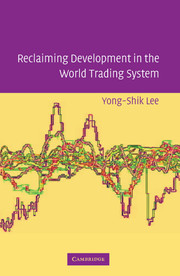Book contents
- Frontmatter
- Contents
- List of Abbreviations
- Acknowledgments
- 1 Poverty, Economic Development, and International Trade
- 2 Current Regulatory Framework for International Trade: The WTO System
- 3 Reclaiming Development: Tariff Bindings and Subsidies
- 4 Anti-Dumping and Safeguards
- 5 “Expansion” of Trade Disciplines and Development
- 6 Foreign Direct Investment and Regional Trade Liberalization
- 7 Conclusion: Putting Back the Ladder
- Epilogue
- Bibliography
- Index
6 - Foreign Direct Investment and Regional Trade Liberalization
Published online by Cambridge University Press: 18 August 2009
- Frontmatter
- Contents
- List of Abbreviations
- Acknowledgments
- 1 Poverty, Economic Development, and International Trade
- 2 Current Regulatory Framework for International Trade: The WTO System
- 3 Reclaiming Development: Tariff Bindings and Subsidies
- 4 Anti-Dumping and Safeguards
- 5 “Expansion” of Trade Disciplines and Development
- 6 Foreign Direct Investment and Regional Trade Liberalization
- 7 Conclusion: Putting Back the Ladder
- Epilogue
- Bibliography
- Index
Summary
Regionalism in International Trade and Investment
While the global multilateral trading system represented by the WTO provides a regulatory framework for international trade today, more than 130 regional trade arrangements (RTAs) also exist. Regional Trade Agreements are authorized by the WTO and include important economic entities, such as the EU, and they have significant effects on international trade because about 90 percent of WTO Members, including a number of developing country Members, have signed at least one or more RTAs. The trade of many developing country Members is thus affected by the terms of RTAs as well as WTO disciplines. Therefore, RTAs create significant implications for the economic development of developing countries just as WTO rules affect the ability of these countries to adopt development policies. The trade of developing countries not participating in particular RTAs may also be affected by the terms of these RTAs because the competitive position of their exports in the markets of RTA members (“members”) may be relatively weakened by trade preferences offered to the members but not to the non-member developing countries.
Most of these RTAs are free trade agreements (FTAs). An FTA is an agreement between two or more countries to eliminate both tariff and non-tariff trade barriers and thereby create a free trade area among the participating countries (e.g., the North American Free Trade Agreement [NAFTA], the Jordan–U.S. Free Trade Agreement).
- Type
- Chapter
- Information
- Reclaiming Development in the World Trading System , pp. 141 - 155Publisher: Cambridge University PressPrint publication year: 2006



